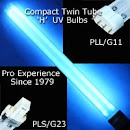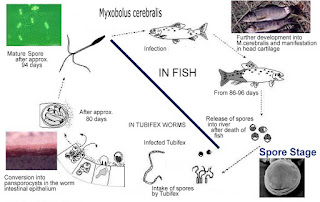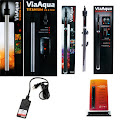By Carl Strohmeyer-PAMR 40+ years experience
Updated 5-18-23
Whirling Disease (Myxobolus cerebralis) in Fish, primarily SA Cichlids
Whirling disease is a disease of freshwater fish caused by the myxozoan parasite Myxobolus cerebralis. This infection/infestation is most commonly found in the wild found in the salmonid family of fish, however is not very common with most fish kept in aquariums except under the right conditions and that come from certain sources.
What is noteworthy mostly for prevention is that the parasite has two hosts — the fish itself and a freshwater oligochaete worm, popularly known as the Tubifex tubifex. This is a major reason these worms should not be fed, but unfortunately are a common source of cheap protein for many fish farms, especially those selling to discounters.
This has been documented in particular with Cichlids coming from certain fish farms.
Water temperature also has an influence on all stages of the parasite life cycle since it slows its cycle over 70°F (21°C), as spores are released from the worm host when the temperature is between 10°C and 15° C.
However once infected, and while a higher temperature will check the spread, it will not significantly help for an infected fish based on my experience.
"Whirling Disease" gets its name from the radical tail-chasing swimming behavior of heavily and often fatally infected fish.
Clinical signs result from the presence of the parasite spores in the cartilage, causing inflammatory changes and pressure on spinal nerves. However, fish may become infected with the parasite and never show clinical signs; resulting in a difficult positive diagnosis of infection in these fish. Reference: Disease Strategy Manual - Whirling disease
ADVERTISEMENT
SIGNS OF INFECTION/DIAGNOSIS
Please note that symptoms do not always appear and even then these symptoms do not confirm a diagnosis of Myxobolus cerebralis, only microscopic slides can confirm.
- Infected Fish will "whirl" forward in an awkward, corkscrew-like pattern instead of swimming normally. This behavior change generally takes about 35 to 80 days after initial infection.
So if you have had your fish for 6 months in an aquarium kept at 80°F (27°C), most likely your fish does NOT have Whirling Disease - It is much more common for new fish to be infected with Myxobolus cerebralis, especially that come from discounters selling fish from fish farms utilizing ponds or using Tubliflex worms as a cheap source of protein.
It is also noteworthy that this is more commonly a disease of cooler water fish based on the life cycle, HOWEVER, I have had several confirmed cased of Whirling Disease in Cichlids in particular. - Fish infected with worms also infected with Myxobolus cerebralis may have lower body mass and may be discolored in the area near the tail
This video below shows a trout with advanced "Whirling Disease", also displaying darkening of the tail that sometimes occurs in advanced stages.

YouTube; Whirling Disease
TREATMENT
- Prevention is the #1 treatment; KNOW YOUR FISH SOURCE or your Retailers fish source!
Retailers selling fish distributed by Aquatropic is a good starting point.
Reference: Aquatropic - Nitrofurazone (Either pharmaceutical grade AAP Furacyn or lower grade Furan 2) combined with AAP Super Ich Plus or ParaGuard for in tank treatment.
Methylene Blue, sodium chloride, along with Super Ich Plus or ParaGuard in a Fish Bath
And Metronidizole & praziquantel as part of a fish food soak.
Further Fish Bath Information:
Fish Baths, Dips, Swabs
Further Fish Food Medications Soak Information
Aquarium Medications; Food Delivery of Medications
Recommended Product Sources that support this FREE Information and the Aquarium/Pond Keeping Hobby:
*AAP Metronidizole
*AAP ParaGuard
*AAP Super Ich Plus
)*AAP Yellow Powder; Premium Nitrofurazone Blend (Best
*AAP Nitrofurazone/Furan 2
*AAP General Cure (source of BOTH Praziquantel/Metronidizole) - An excellent product, Naladixic Acid, can also work for "Whirling Disease", and even more so for symptoms that often mimic Whirling disease in aquarium (but are not actually true Whirling disease). This medication was often very effective from my experience in certain cases and when combined with products such as Metronidazole or Medicated Wonder Shells, especially for Discus and other Cichlids.
Thankfully AAP has been able to bring back Naladixic Acid in the form of the product "Naladin".
Recommended Product Sources:
*AAP Naladixic Acid
*AAP Medicated Wonder Shells - AAP/SeaChem Cupramine can also help (more as a preventative for unaffected fish), not as much as a treatment.
Ditto the Medicated Wonder Shell which has some of the same form of copper as Cupramine and ha the bonus of improving mineral Cations/electrolytes in the aquarium .
Recommended Product Sources that support this FREE Information and the Aquarium/Pond Keeping Hobby:
*AAP Medicated Wonder Shells
*AAP Cupramine
References:
*Ichthyophonus in Fish
A similar disease in both symptoms and the fact both are more common in cooler waters or carried from cooler waters.
*Wikipedia; Myxobolus cerebralis
Other Recommended Reference & Product Sites

Fish Diseases | How to Treat Sick Fish

Freshwater Aquarium Care; Basics to Advanced

Premium UVC Replacement Lamps
For TRUE Premium, Hot Cathode, Low Pressure UVC Germicidal Bulbs, not the low output bulbs/lamps commonly sold at Amazon & eBay
![]()
Premium USDA Aquarium Safe Silicones
*Columnaris & Fungus Infections in Fish
*How Aquarium Medications Work; Part 1

AquaRay Ultra Premium Aquarium LED Lights
Highest in PUR, The ONLY LED with an IP67 rating or higher for water proofing along with a full 5 year warranty to back them up!
Why purchase brands without this rating such as the Finnex, Current, or Fluval only to be essentially placing an electronic light emitting device over your humid aquarium with little or no guarantee? In the long term, you WILL PAY MORE!


